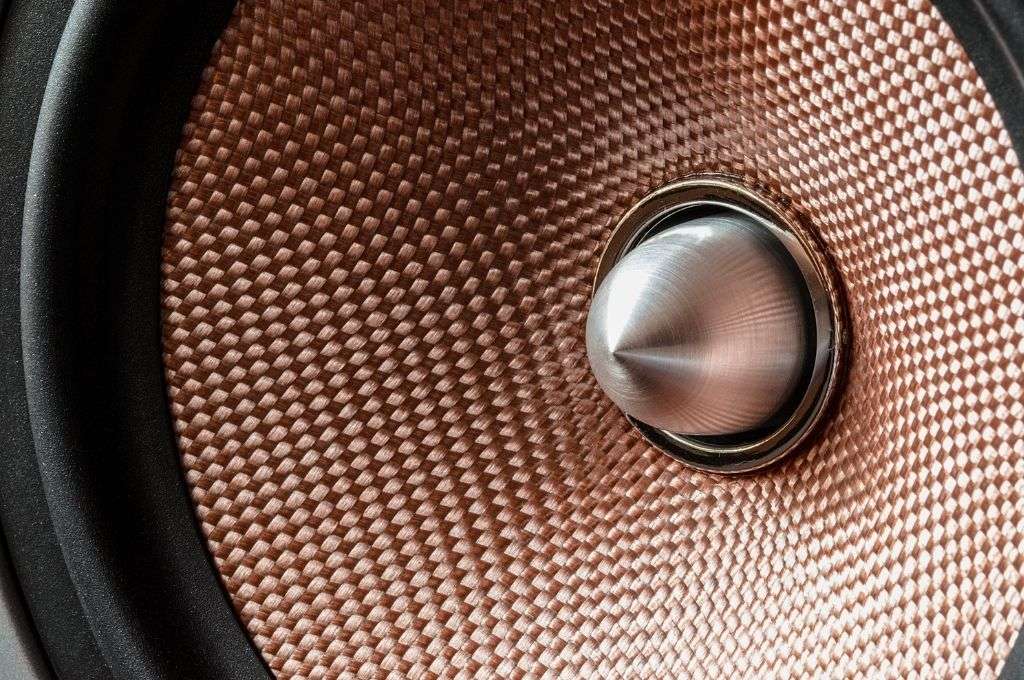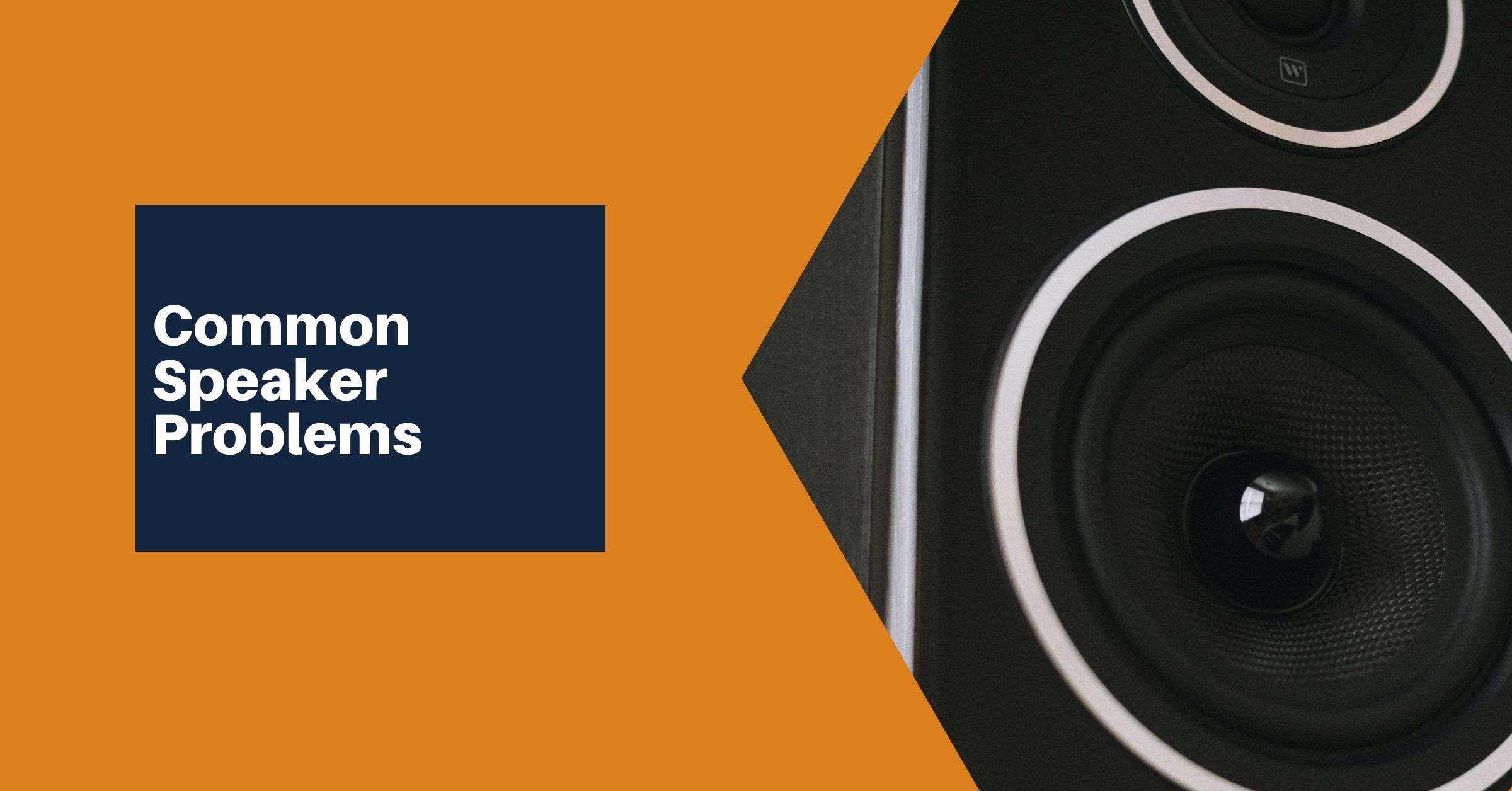Almost every household has a set of speakers. No matter how big or small, cheap or expensive, or new or old, any home sound system can suffer some speaker problems through day-to-day use.
This speaker repair guide explains the basics of how a speaker works, what frequently goes wrong, how to identify a problem with your speaker or sound system as well as what parts and tools you’ll need to repair it.
Whether your speakers are old or brand new, these problems can be very annoying. The good news is that you can resolve almost every speaker problem by replacing parts or changing settings. Let’s get into it!
How do speakers work?
First, to properly understand issues with speakers, you first need to have some general knowledge of how speakers work. Although it appears to be a single unit, a speaker is comprised of several parts:
- The speaker cabinet: The wooden box that the speaker cones are stored within.
- A crossover network: The device that sends certain frequencies to their appropriate speaker cone.
- Speaker driver: The cone is responsible for creating the sound. In its simplest form, speaker cones move back and forth to create pressure waves in the air which is called sound.
Generally, most of the common speaker issues can be addressed within these 3 components above.
Now that you know more about how your audio equipment works, let’s get to the nitty-gritty of speakers’ life, how they typically break and what signs are there to look out for when troubleshooting for issues.
How long should loudspeakers last?
When properly cared for, high-quality loudspeakers can last for decades. The lifespan factors are design quality, environment, connected amplifier(s), and usage time. While safe operation increases speaker longevity, even the most careful of listeners will eventually have a speaker issue.
Even cheaper speakers can last for five years or more if used regularly. But unfortunately, these low-cost models get frequently built with lower quality components that will eventually fail. This leads listeners to frequently replace them to get new ones since it’s often more cost-effective to simply buy new units rather than take the time and money to repair the existing ones.
On the other hand, high-end speakers should last for decades if properly cared for. Some 50-year-old speakers continue to perform incredibly well, even without repair. Others will work for long periods but need parts replaced throughout their lifespan – most often the speaker cones.
Material and quality matter a lot when it comes to the lifespan of the speakers. If you are looking to invest in new speakers, it’s safe to say that the better option is to get a higher-end loudspeaker.
Can speakers be repaired?
In short, yes. But based on how it broke, repairing your speaker to functional use may or may not be worthwhile. When a cone or cabinet is harshly damaged, it’s often not worth repairing.
However, if you don’t have the money or time to go out and buy a new speaker, there are a few things you can do to try to repair your broken speaker cone.
Electronic and audio stores sell replacement speakers, speaker repair kits, foam, wire, and other parts and materials. You may also require the following items:
- Multimeter
- Rubber cement
- Patch or repair kit
What can damage speakers?
Many things can lead to damage to the speakers. Some of them may not seem like a big deal, but they can cause distortion in your sound system and lead to injury.
- Overpowering or underpowering. You can have a 1000 watt speaker, but if you use a 50-watt amp with the volume turned up more than halfway, it will produce a square wave or clipping, and the lousy signal will damage the voice coil.
- Bad wiring in the speaker cabinet, in the cabling to the speakers, from the amp, and throughout the building can result in an intermittent signal and transients that can damage a speaker.
- Exposure to the elements. Speakers do not tend to fare well when exposed to extreme temperatures and moisture. It’s best to keep speakers indoors at a stable temperature unless they are specifically designed to withstand harsh environments.
- Loud volume can cause a fried voice to coil over time. When your audio system is always on the top volume, the audio quality will deteriorate over time.
Why do speakers get distorted?
When you listen closely to a cheap audio system, you may notice distortion in the audio. If the audio system is of poor quality, it can easily be damaged at high volume, regardless of how powerful the amplifier is. It is because the drivers extend further and faster as the volume increases.
The increased movement generates heat within the speaker. Heat damage may occur if the speaker components are of poor quality. It eventually leads to distortion in the sounds.
When your speaker is playing at low volumes, the damage may be invisible, but the damage becomes more visible as the power increases.
Common speaker problems and their solutions

Common speaker problems are often no sound, audio distortion, blown speakers, lack of bass or treble, or hums and buzzes. These problems stem from a variety of issues, but usually can be fixed by making adjustments to the speakers or receiver.
Here are six common speaker issues that people regularly have:
Problem: No sound coming from speakers
One of the most common and also open-ended issues is a lack of sound coming from your speakers. The issue can be a simple fix or a complicated repair.
Solutions
If you can’t hear any sound from your home audio system, try the following:
Make sure the speaker isn’t muted
Because muted speakers never produce sound, your solution may be as simple as unmuting the speaker. Make sure to check your speakers, receiver, and the device you’re using to provide the audio source. You should make sure all three are unmuted if they have that capability.
Adjust the volume
Similar to the muted issue above, if the speakers, sound system, or audio source are turned to low or no volume, the speakers will not produce sound. Test this by turning all devices up to a moderate level, but not too loud!
Test the audio system source
If the options above don’t work, it’s time to start isolating the problem. Test the different audio systems in different ways. For instance, if you’re trying to play music from a phone, make sure the phone still plays properly through its internal speakers and/ or a different set of speakers.
Same thing for your audio receiver. Test different channels and devices like a turntable, laptop, etc. Is this issue consistent across different devices?
Once you’ve confirmed that the devices work properly, you can isolate the issue to the speakers themselves.
Check speaker cables and electrical wires
Speaker wire can sometimes collect dust and debris which can cause speaker issues. Inspect in clean all speaker wires to ensure this isn’t the issue.
Also, if you have powered or active speakers, make sure the power supply is functioning properly and provides power to the speakers.
Problem: Audio distortion
If you’re hearing sounds of fuzz, buzzing, or other feedback that should not be included in audio, it could be a sign of distortion in your audio system. There are a few things you can do to fix this audio issue:
Solutions
Make sure it’s not your device
Firstly, it’s important to make sure the issue isn’t stemming from the device connected to your speakers. Turntables especially can create their own separate distortion issues. We recommend you listen to multiple devices when locating a distortion issue.
Check cables and connections
After determining that it’s not a specific device issue, check all the cables that go from your speakers to the audio system. Unplug, examine, and clean if necessary. Over time, dust and debris can get into the connections of cables and cause distortion issues.
Additionally, if you’re using an old speaker cable, it might be time to replace it.
Check the speaker voice coil
If all of the above check out, your speaker coil could possibly be damaged. This often happens when music is played at too high of volumes or the EQ is set too aggressively, producing more highs or lows than the speaker was meant to handle.
Try plugging in a different speaker to your system using the same cables. If the audio quality improves, you can likely assume either your speaker voice coil or cone is damaged.
Problem: Blown speakers
A blown speaker is a huge frustration. It can begin with noticing a weird sound when you listen closely and wondering if you’re imagining it and progresses until the problem worsens.
So let’s take a look at what it sounds like, why it happens, how to test for it, and, if possible, how to fix those blown speakers.
What are some of the symptoms of a blown speaker?
The sound of a blown speaker is relatively apparent – a fuzzy, distorted, crunchy noise that may or may not reproduce the audio you are sending through it.
If one of your speakers has failed, the first thing you’ll notice is a noticeable difference in sound quality. A blown speaker will produce static buzz, fuzzy noise at loud levels, and distortion at all levels or no sound if it gets partially blown. Paying attention to the change in voice will help you figure out the issue.
Paper cones in older or lower-end speaker models are prone to issues. The high volume can easily rip the paper cone if too much power is applied.
Solution
If your cone has ripped or separated from the fabric surrounding it, you can glue it back together with silicon rubber gel as a temporary fix. It is critical to use silicon because it is flexible; otherwise, it will cause another tear and worsen that blown speaker.
If you’re not getting any sound from a single speaker, track down the wiring back to the amplifier and check for any loose connections. If none of that works, you’re probably dealing with a fried voice coil.
It’s best to eventually replace the speaker cone with a new one of the same size and quality.
Problem: No bass or treble
Bass and treble are the high and low tones of music. If you’re noticing that your home audio system sounds muffled or thin, it could be due to a couple of things:
Solutions
- First, as with many of these issues, test with a few different devices such as a phone, turntable, and laptop. If the issue persists, you know it’s related to your audio system.
- Your speaker or stereo EQ settings could be improperly set. To test this, make sure the “high, mid, and low” settings on your stereo and speaker (if present) are set in the middle. If this returns that sound that was missing, great – easy fix!
- Make sure your speakers are properly placed. Speakers placed poorly in a room can cause excessive bass in audio.
- This could also be related to dirty or old speaker cables. As cables age, some of their audio fidelity can deteriorate.
Problem: Hums and buzzes
Hums and buzzes are low-frequency noises produced by a woofer turned on even though no music has to get played. These noises have a frequency of around 60 hertz.
Solution
Make sure all devices in your audio system are properly grounded. Some of the most common issues related to speaker hums are due to improper grounding.
Problem: Issues with surround sound system
Do you have an issue with your multi-speaker surround sound system? You may be experiencing no audio, a lack of surround sound effect, or surround sound audio coming from the wrong direction.
You may have placed the satellite speakers incorrectly in the case of incorrect surround sound direction. Here are some solutions to fix surround sound to get your entertainment system working!
Solution
To determine speaker placement, consult the speakers and the user manual. In the case of wired surround sound systems, it is also possible that the wrong wire got connected to the wrong channel on the amplifier output terminals.
So first, identify the cables back to see which port leads to which speaker, and then check the user manual to ensure it’s the right one.
If all you hear from the audio system is a buzzing sound or distorted sound, there could be an incorrect setting or a problem with the speakers’ surround sound. Replace the speaker wires with a different gauge of speaker wire if applicable.
Final Thoughts

It’s good to know how your speakers work by familiarizing yourself with their internal components.
Knowing what distorts your loudspeaker helps to quickly diagnose issues so you can get back to listening. Our guide describes the several problems that can happen to any speaker when you play them throughout their lifespan.
We hope you found this guide helpful. Thanks for reading!

Lead Editor / Owner
After beginning his career in the video and audio recording industry, Andrew started HiFi Hippo to share his knowledge and passion for vinyl and vintage audio with other readers.
